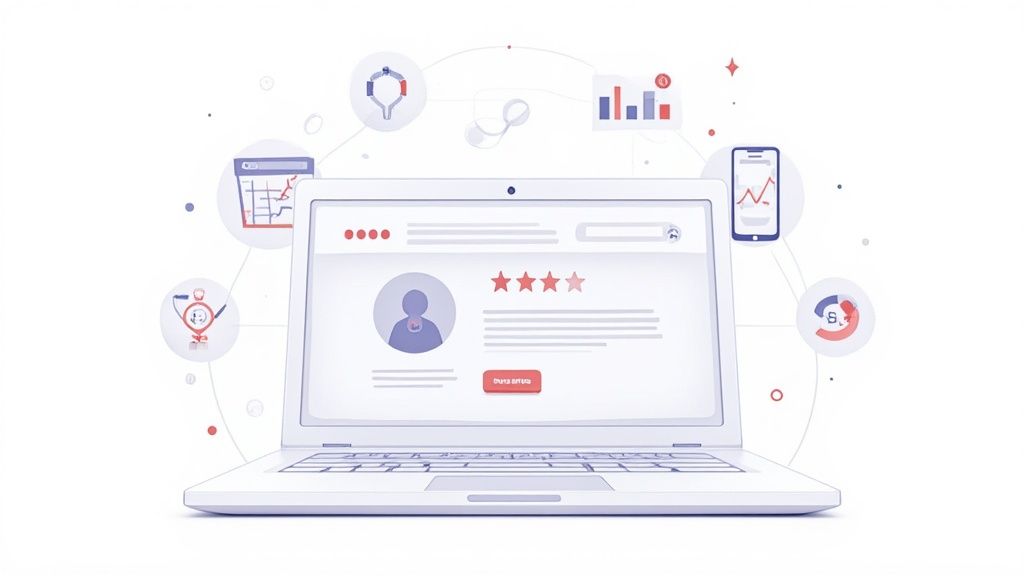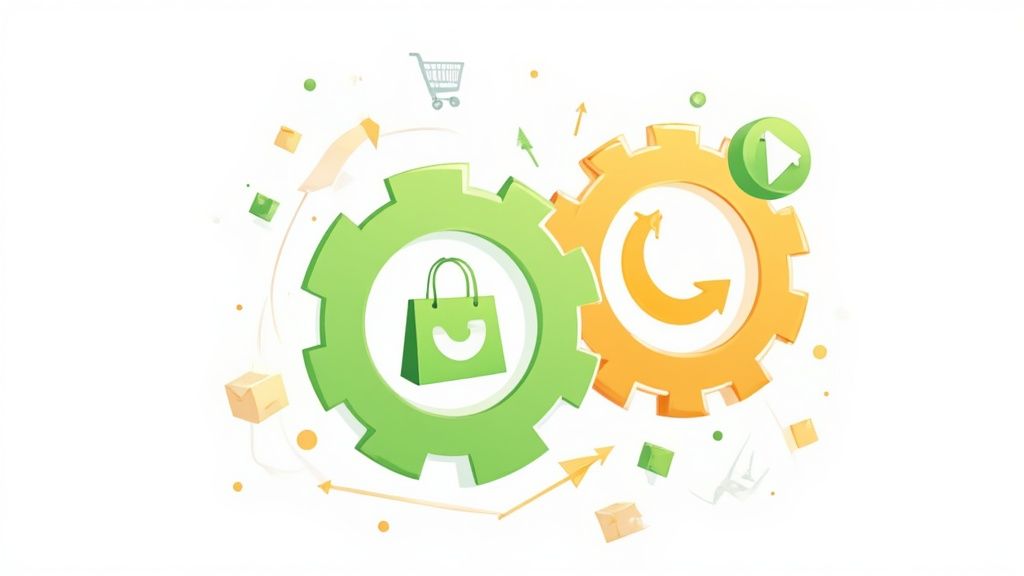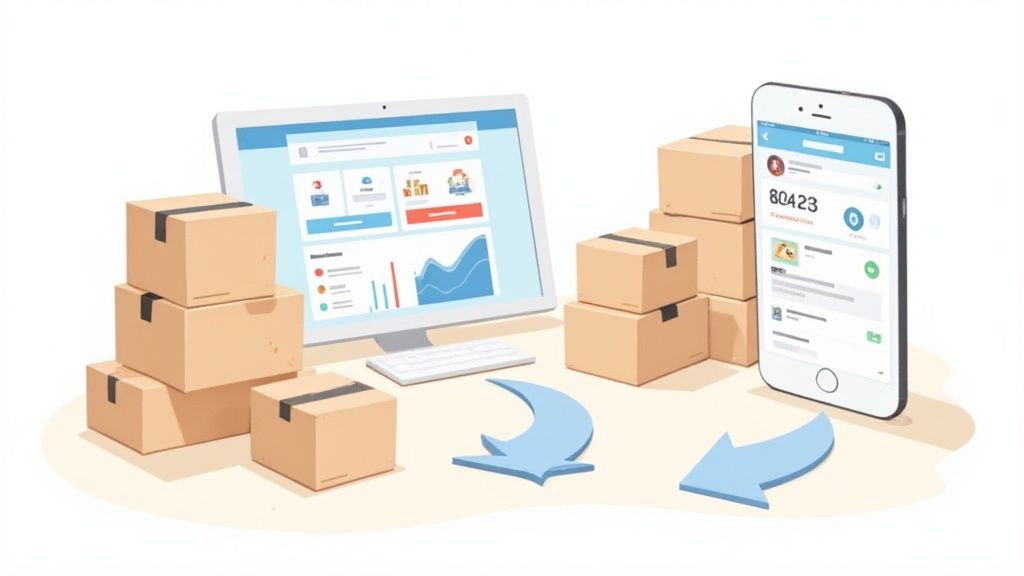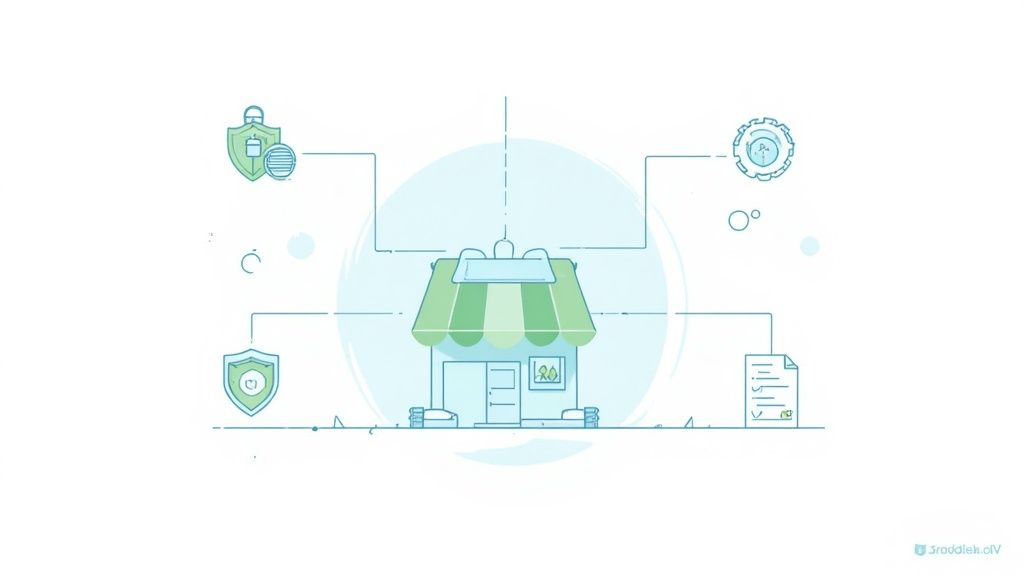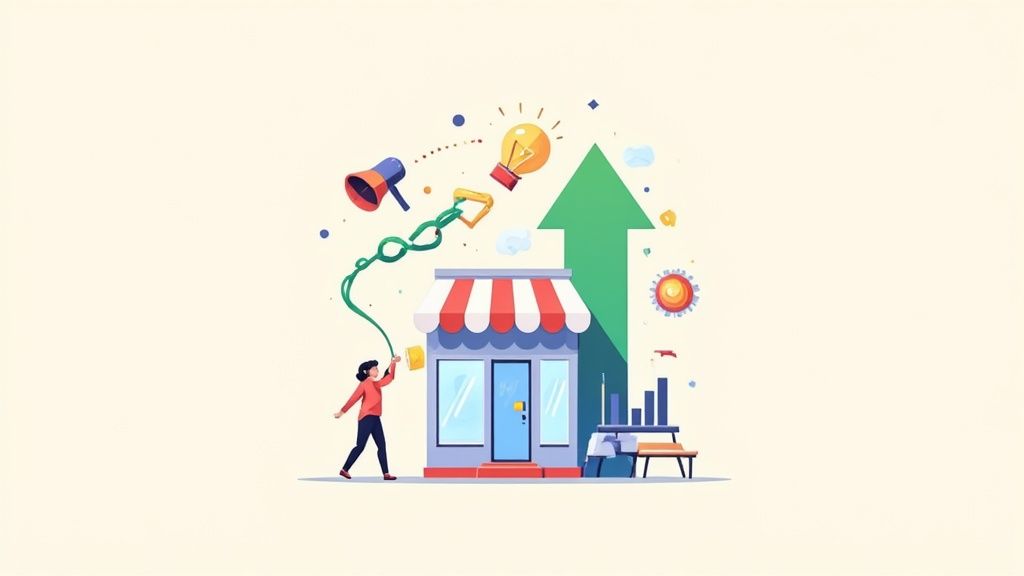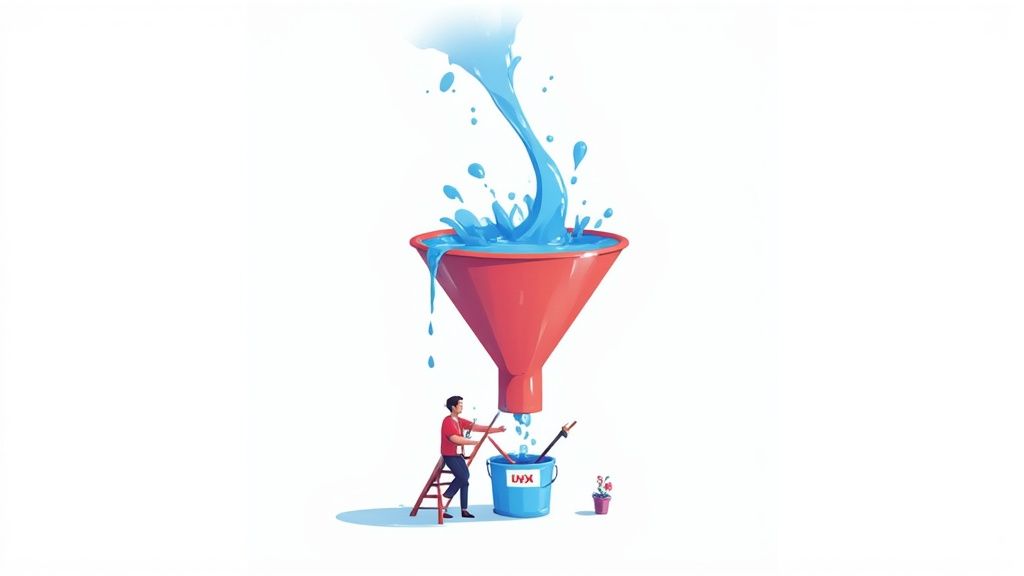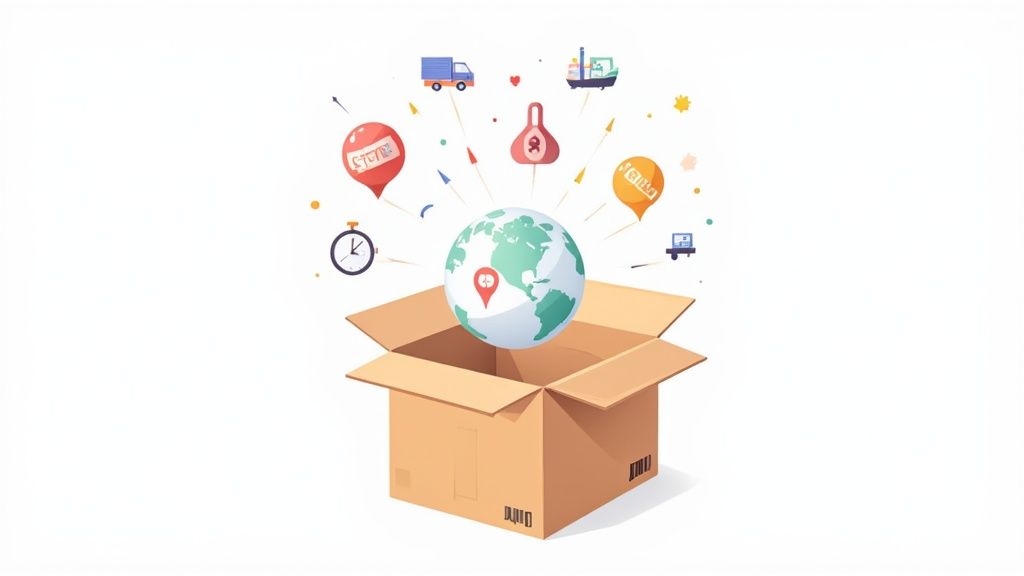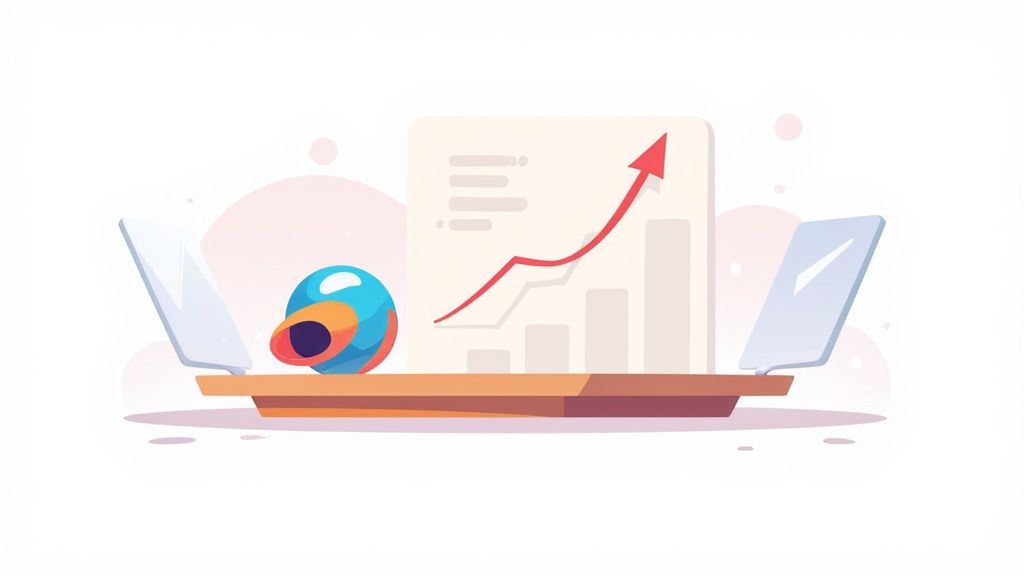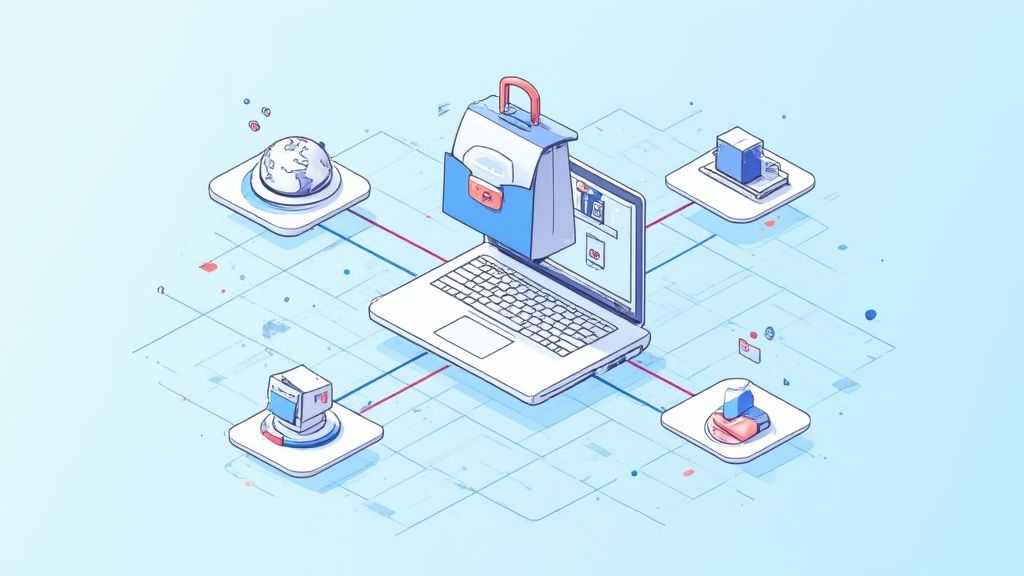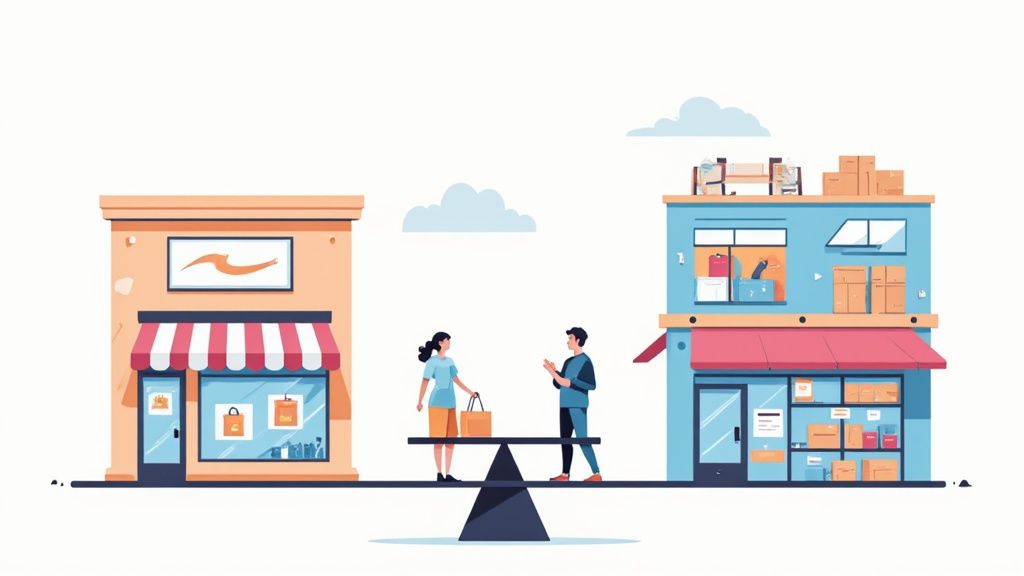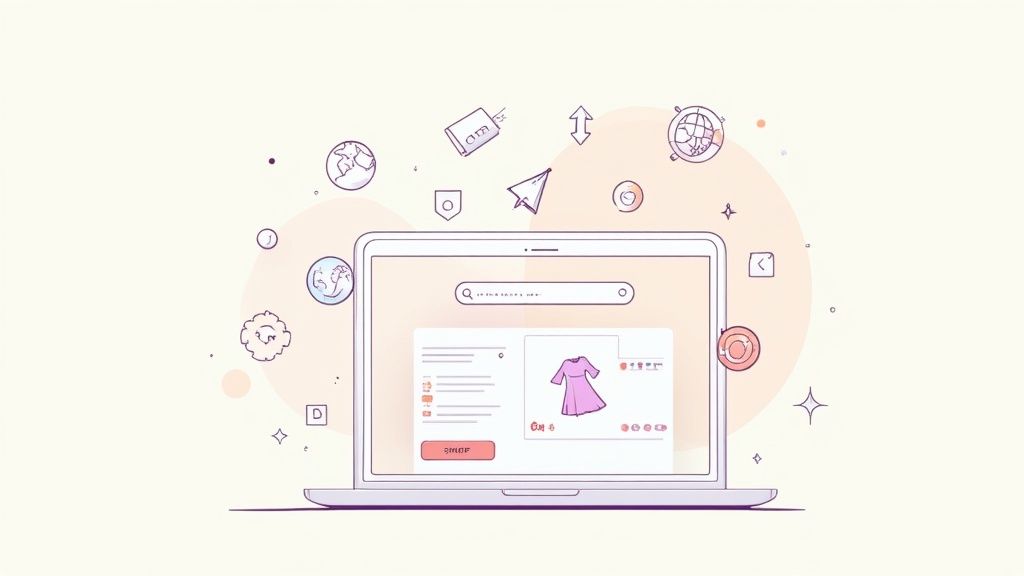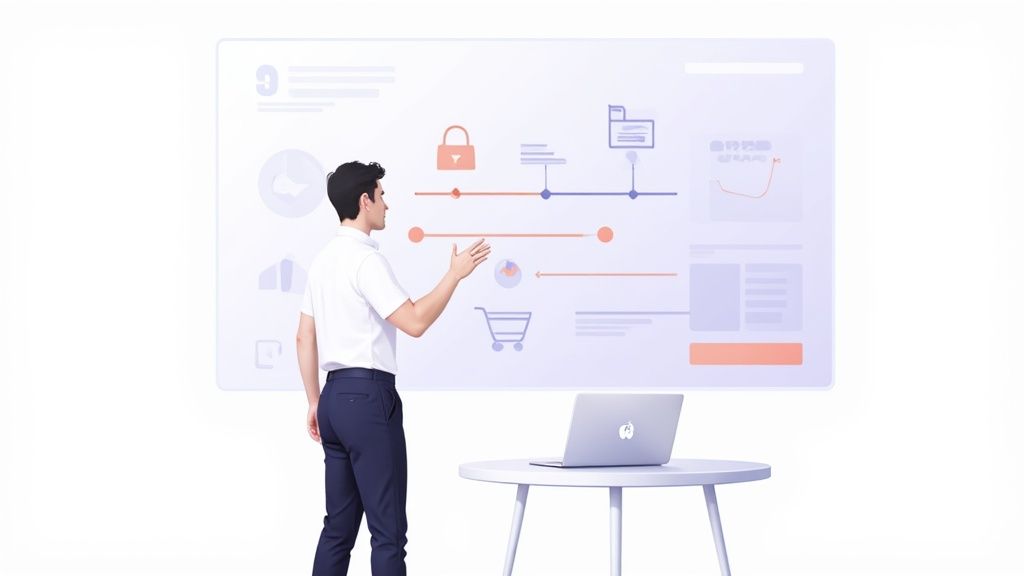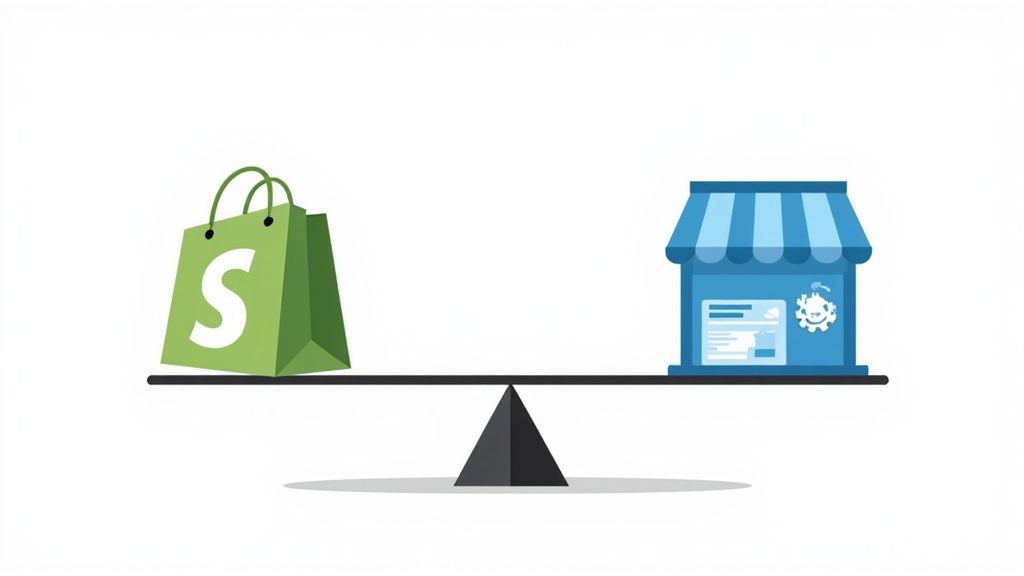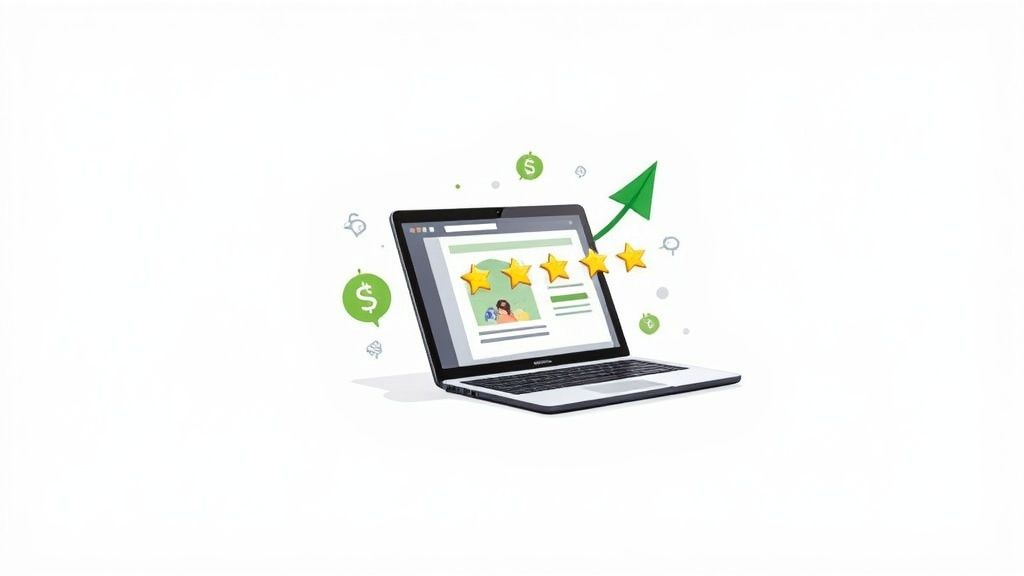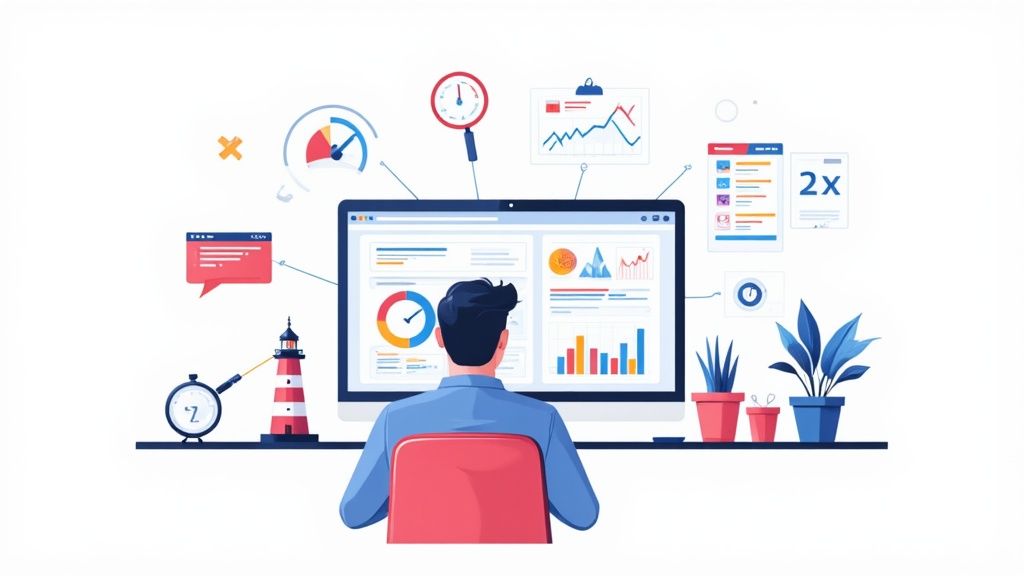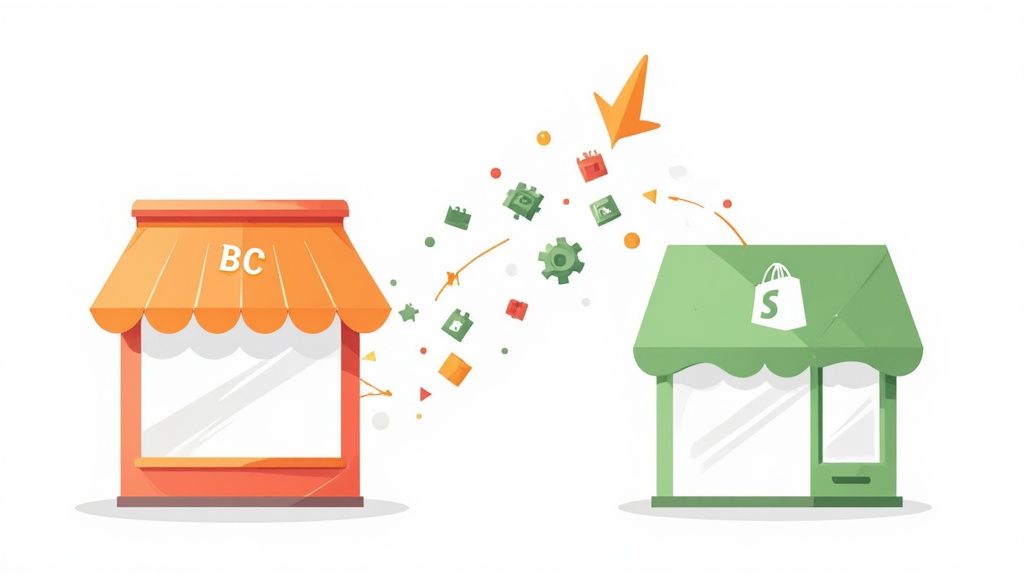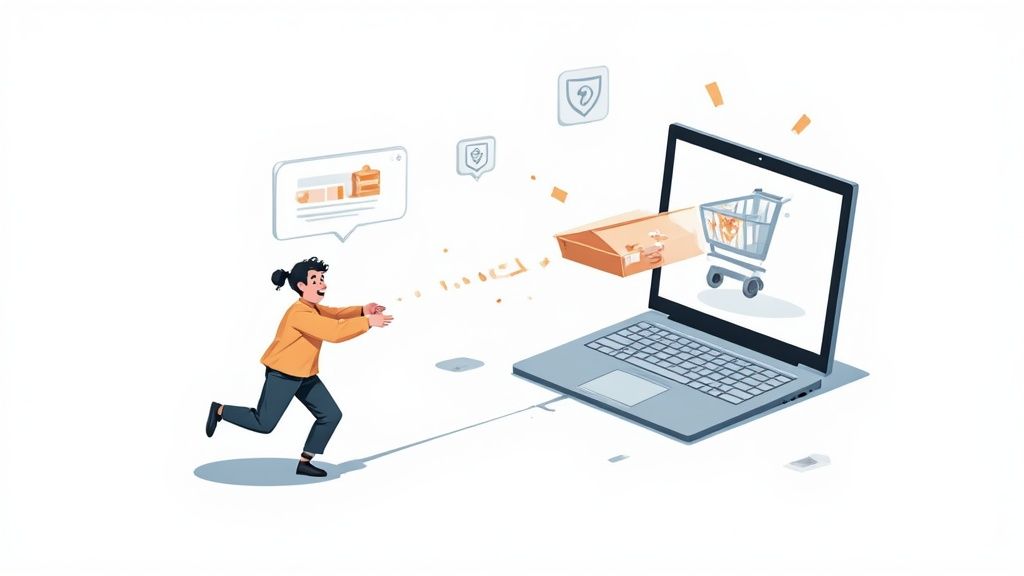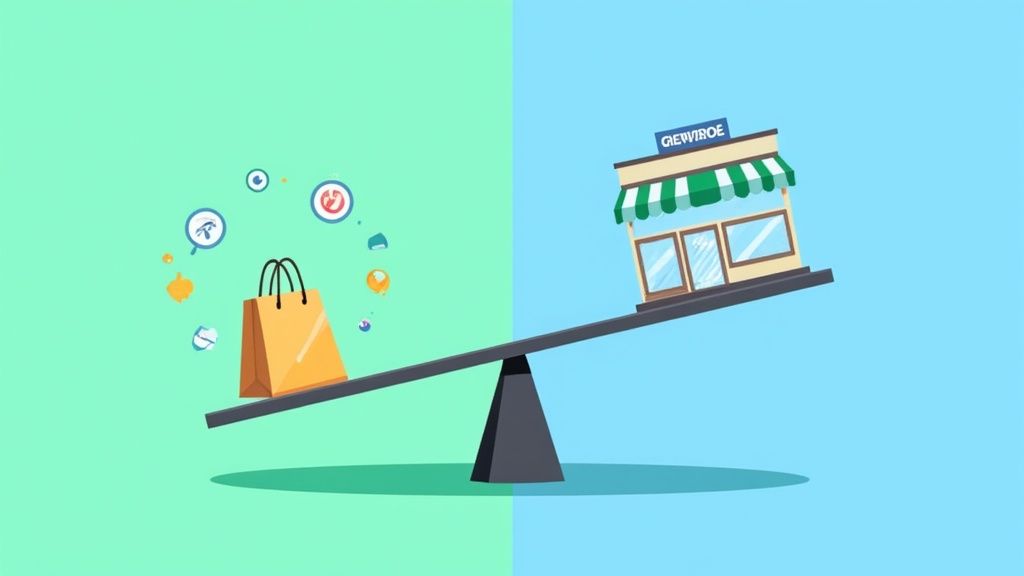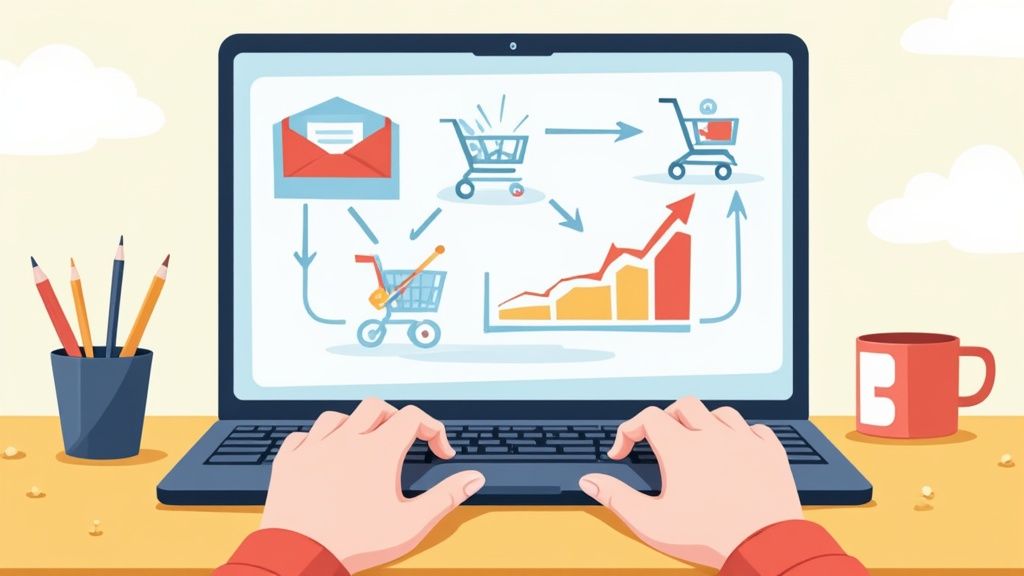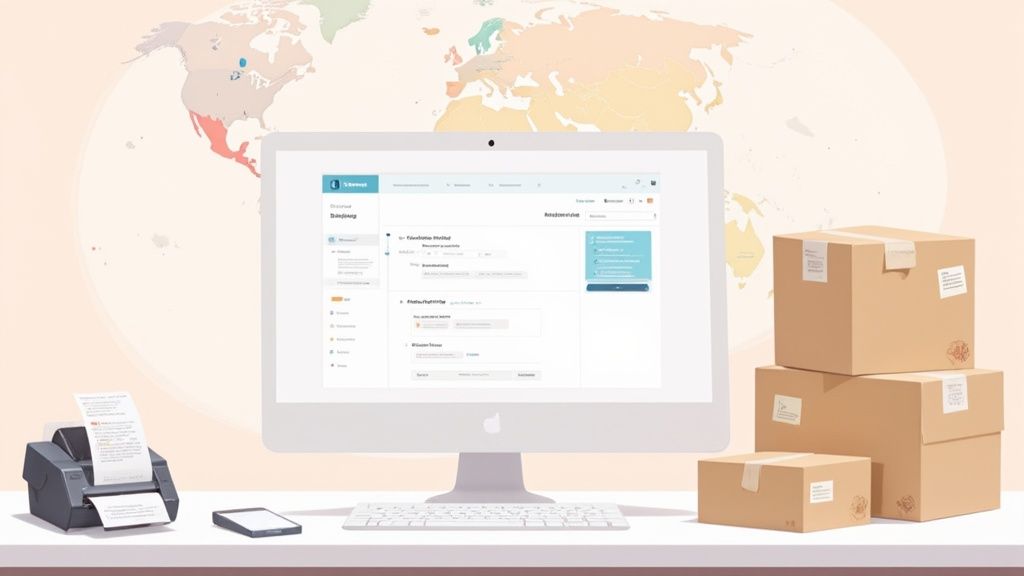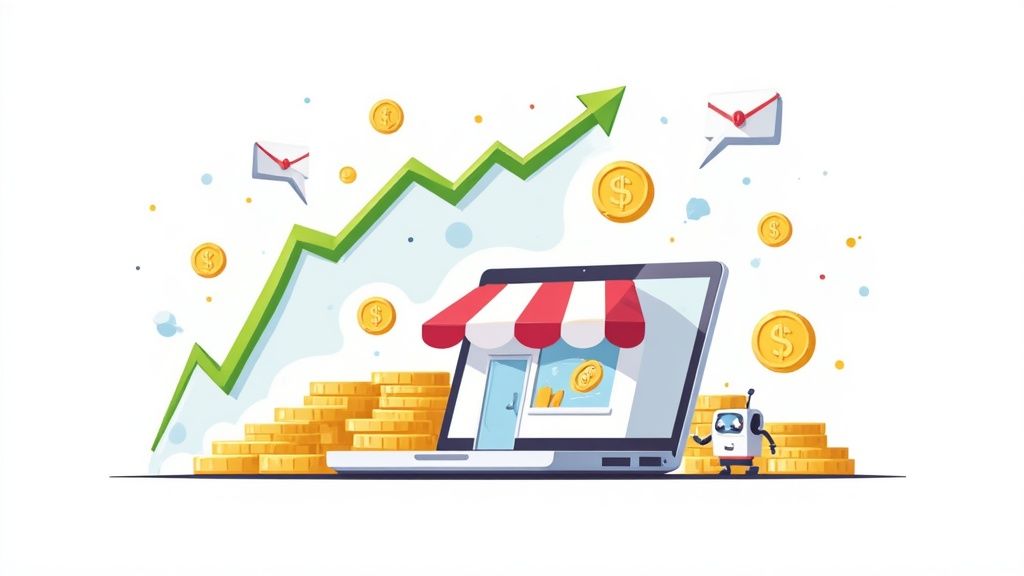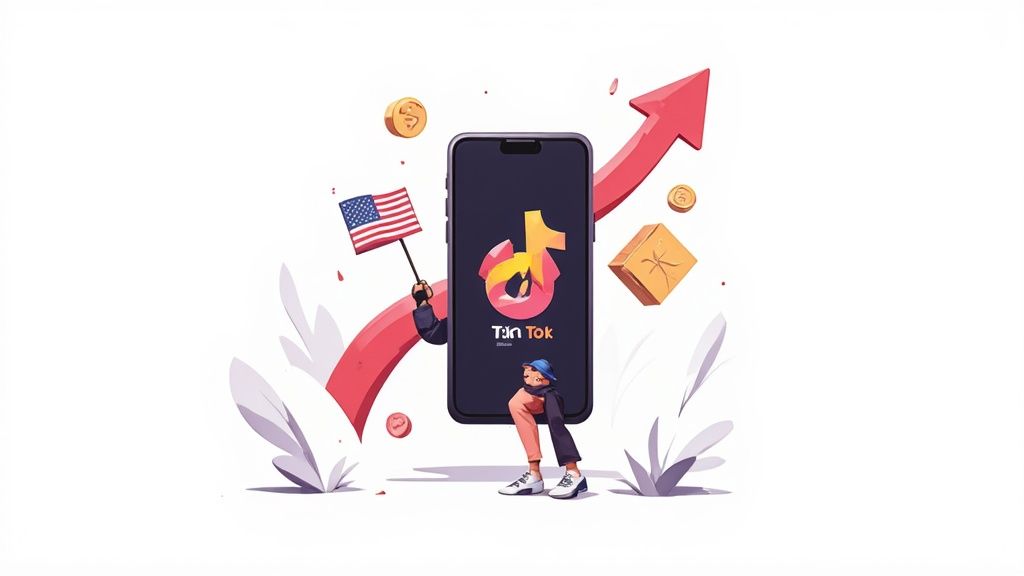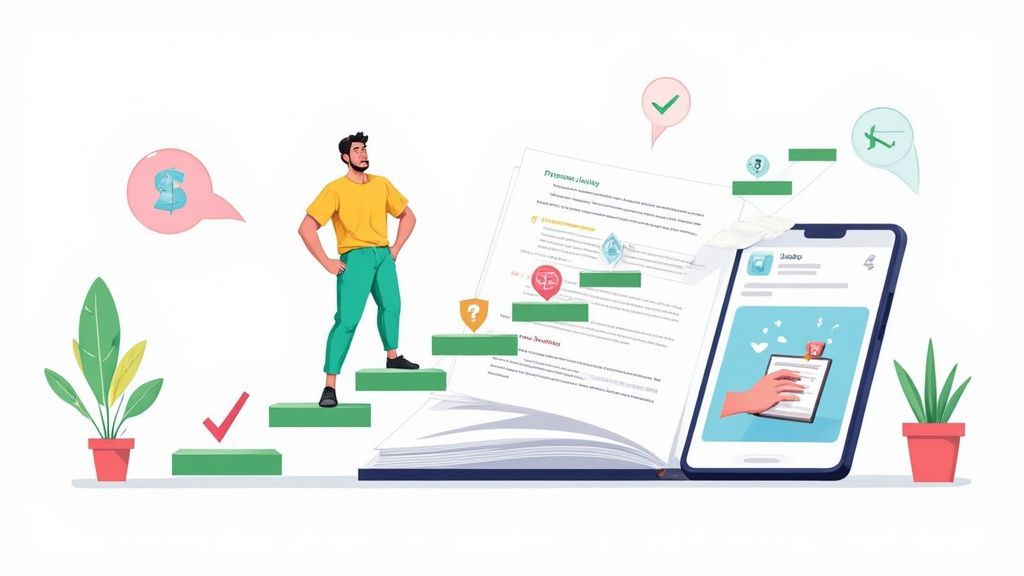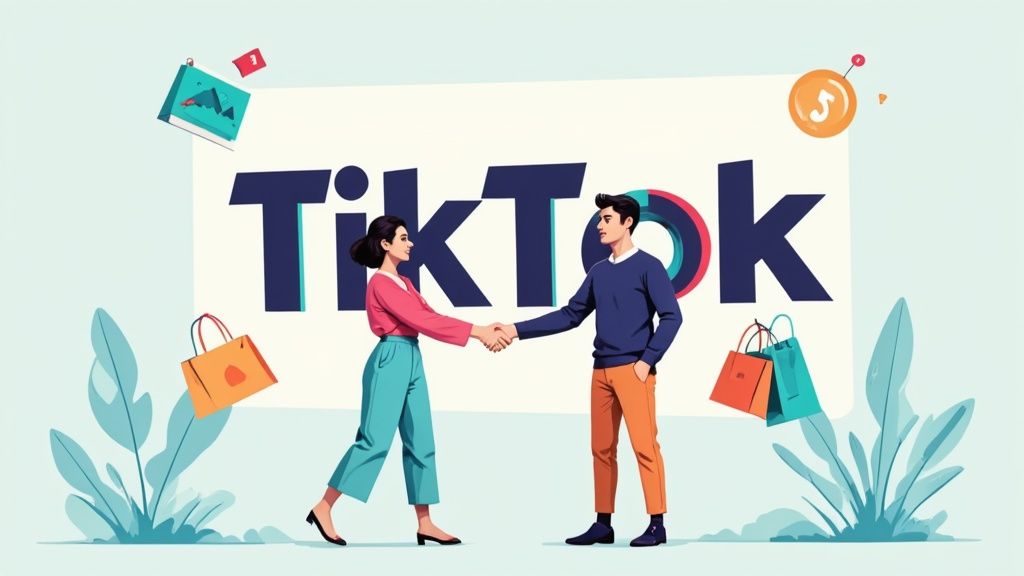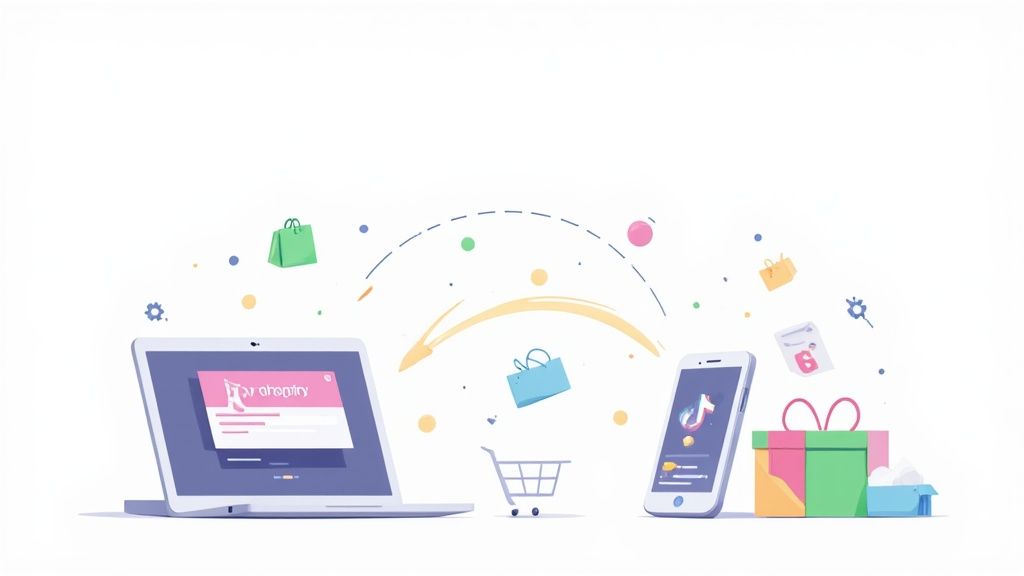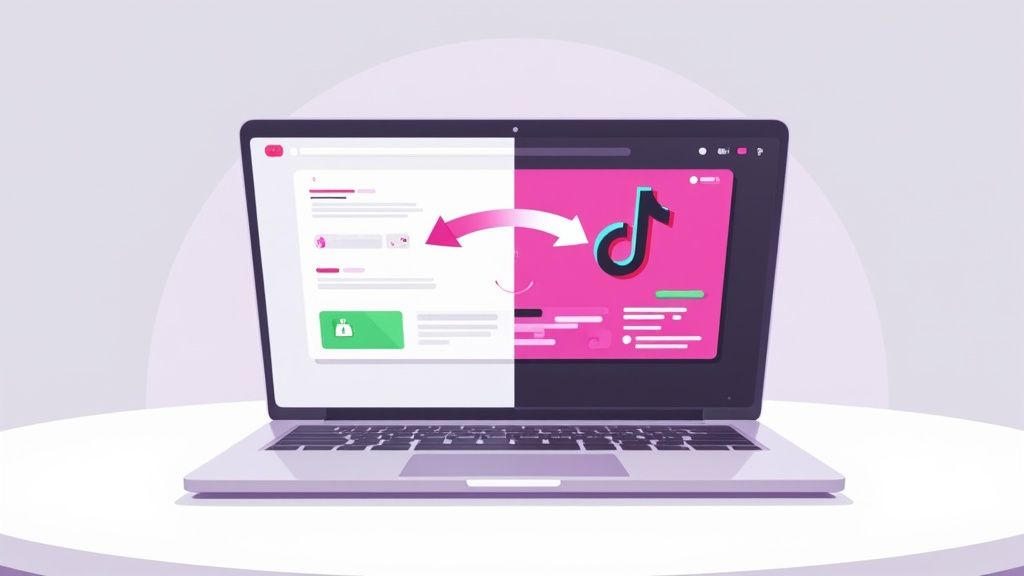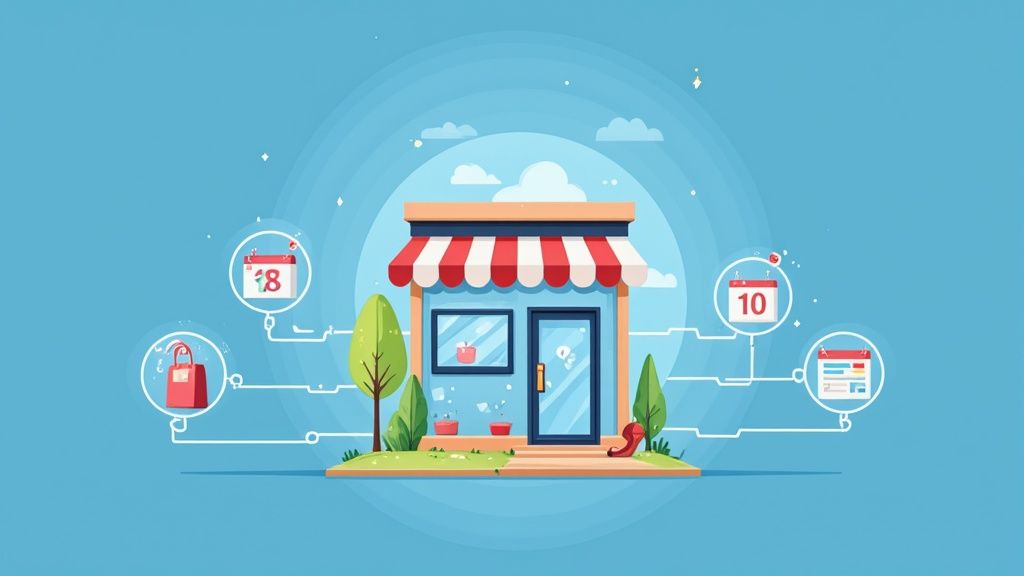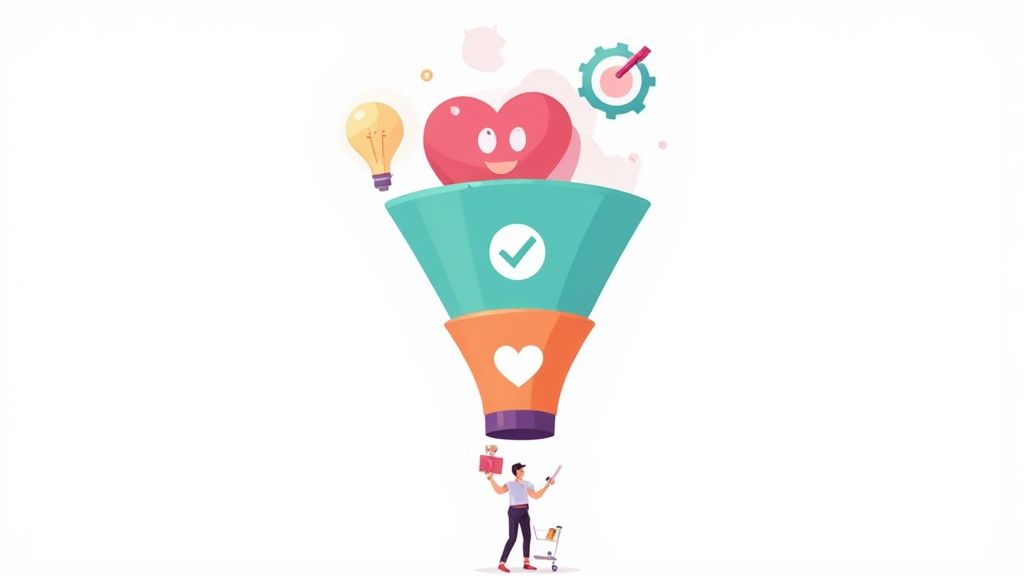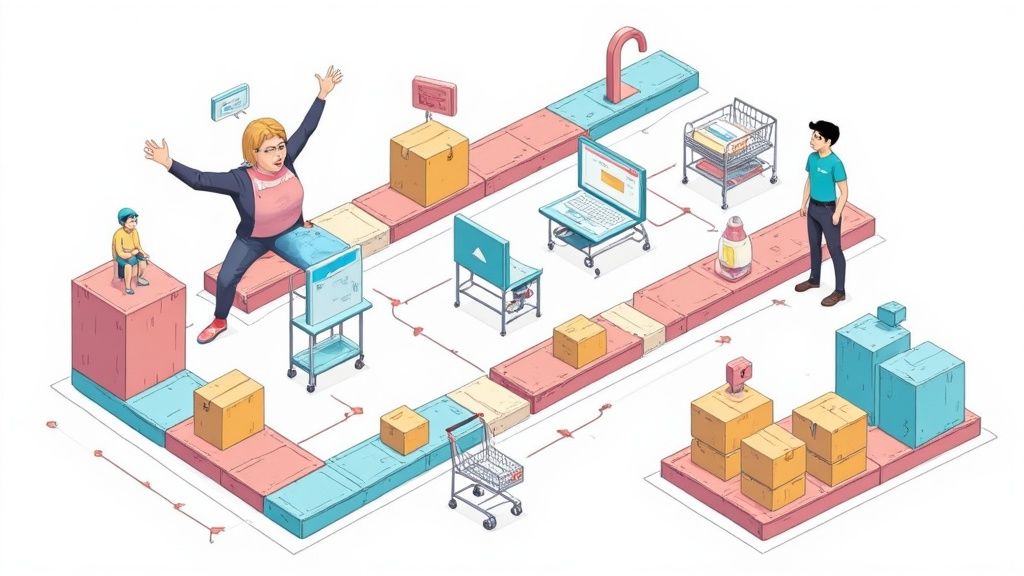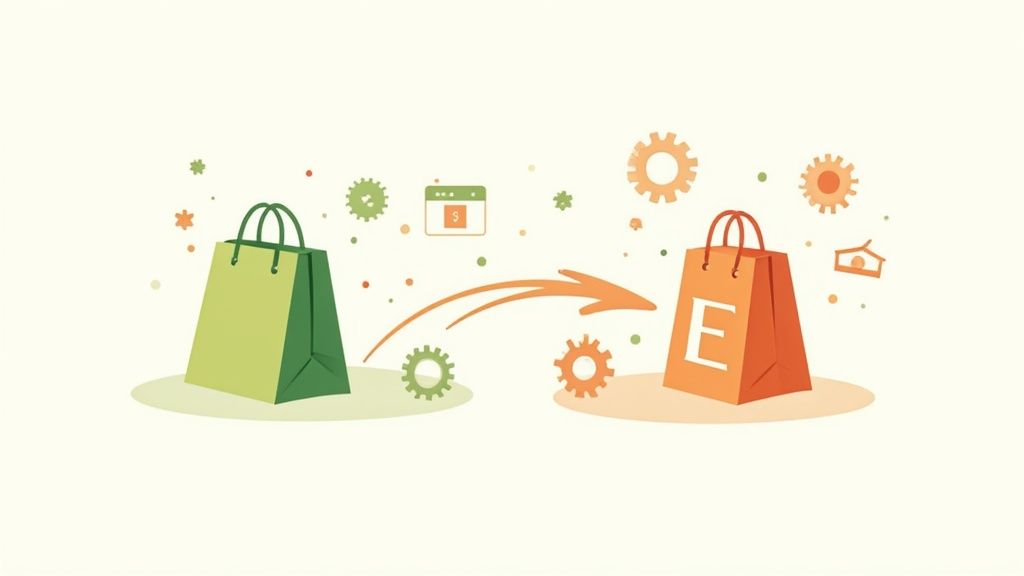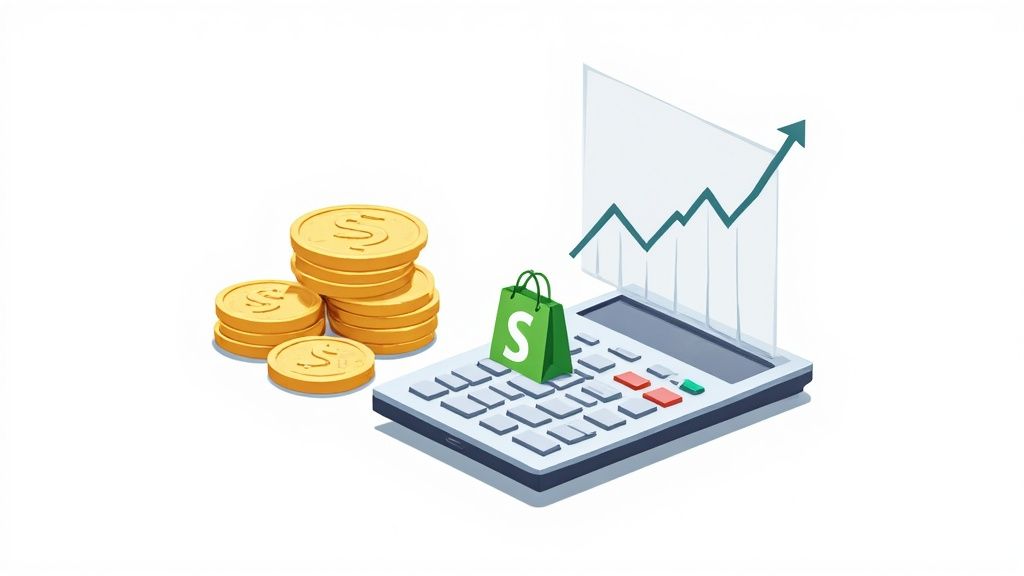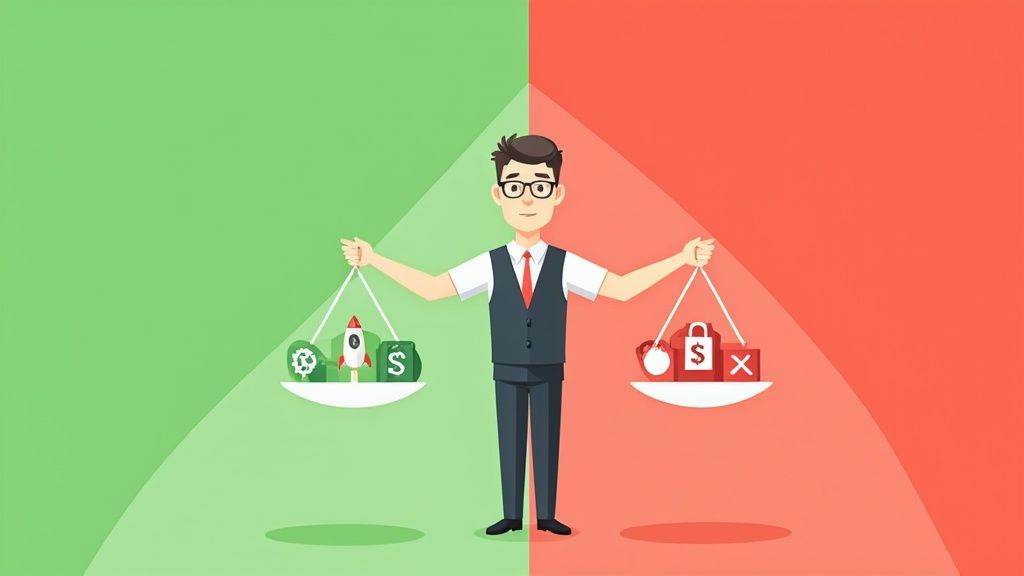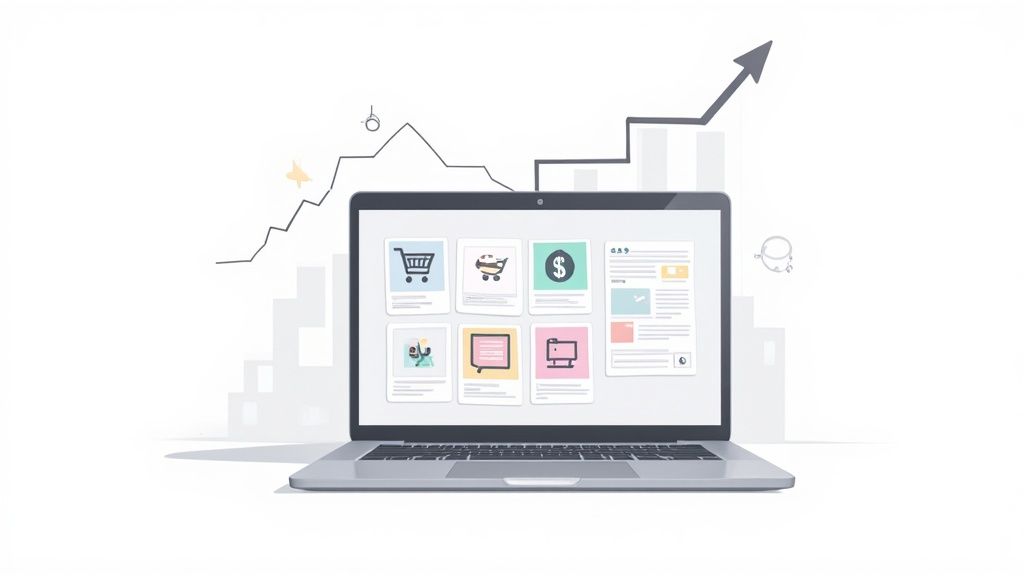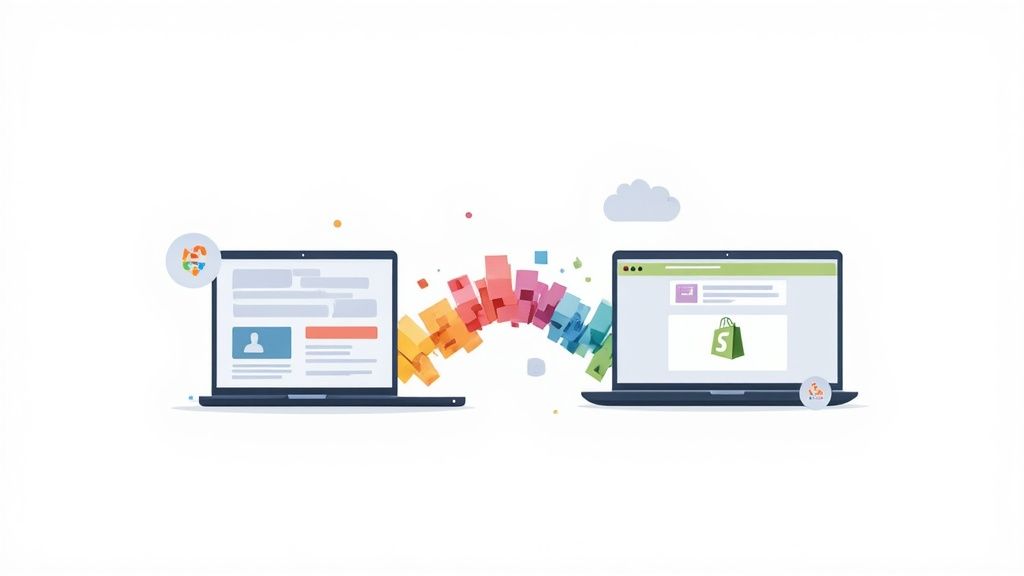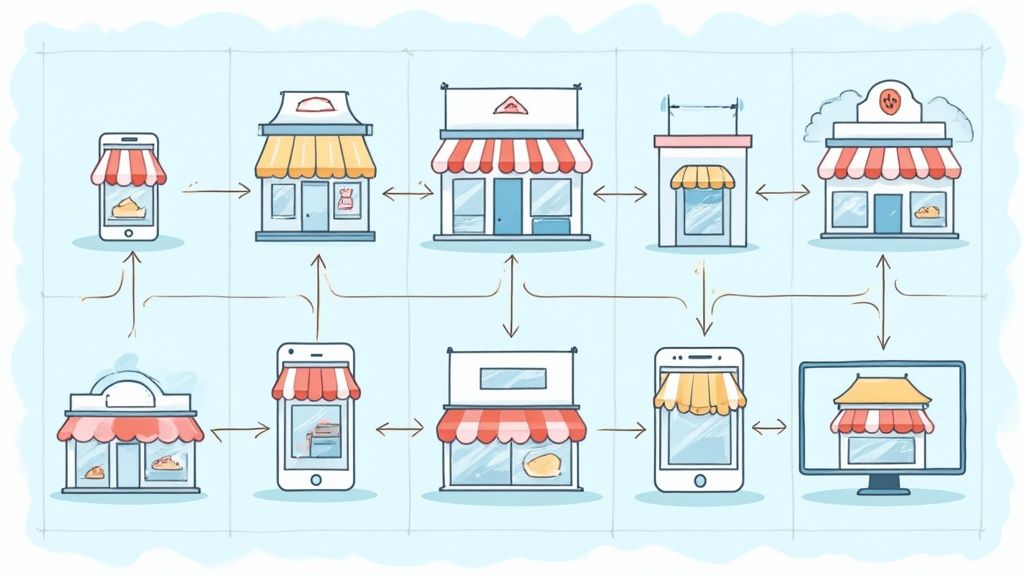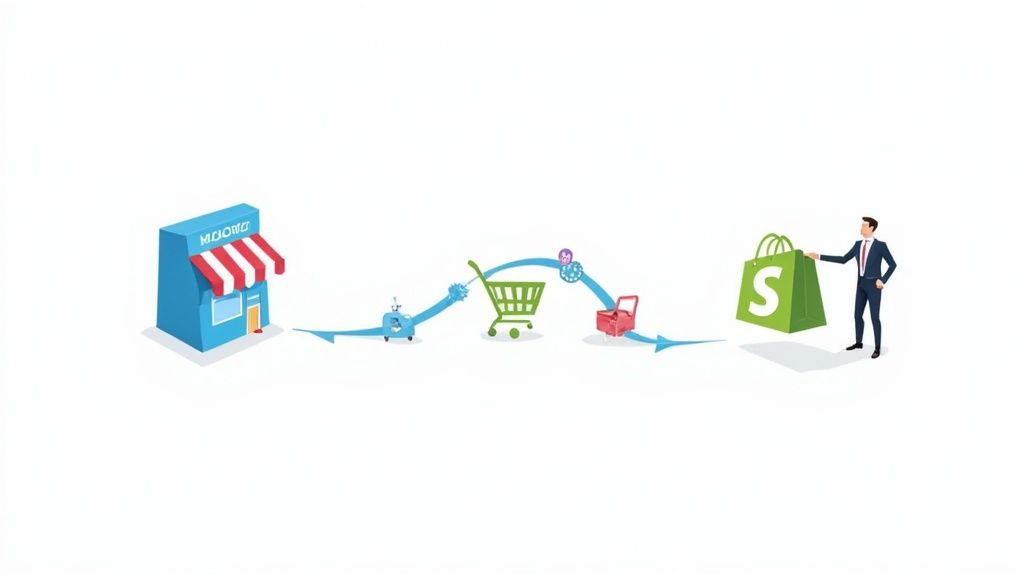
Driving Ecommerce Success in 2025: Key Metrics You Need to Know
This listicle reveals eight crucial ecommerce performance metrics to monitor for success in 2025. Learn how tracking metrics like conversion rate, average order value (AOV), customer acquisition cost (CAC), and customer lifetime value (CLV) can directly impact your profitability. We'll also cover cart abandonment rate, return on ad spend (ROAS), customer retention rate, and the importance of website traffic and organic search performance. Optimizing these ecommerce performance metrics is essential for boosting your bottom line.
1. Conversion Rate
Conversion rate is arguably the most crucial metric for evaluating the effectiveness of your ecommerce store. It represents the percentage of website visitors who complete a desired action, transforming from casual browsers into paying customers or engaged leads. This "desired action" could be anything from making a purchase and adding an item to the cart to signing up for a newsletter, downloading a resource, or even clicking a specific button. Calculating your conversion rate is straightforward: divide the number of conversions by the total number of visitors and multiply by 100. This seemingly simple percentage holds profound implications for your revenue generation and overall business growth, making it a cornerstone of ecommerce success.

Understanding your conversion rate is fundamental for several reasons. Firstly, it directly correlates with your revenue. A higher conversion rate means more visitors are becoming customers, resulting in increased sales. Secondly, it provides valuable insights into the effectiveness of your website and marketing campaigns. A low conversion rate can signal issues with website usability, product pricing, or marketing messaging. Finally, tracking your conversion rate over time allows you to measure the impact of optimization efforts and identify areas for improvement. Whether you’re an emerging business, a growing brand, or an established enterprise, understanding and optimizing your conversion rate is paramount to sustainable success in the competitive ecommerce landscape.
Conversion rate isn't a static, one-size-fits-all figure. It can be measured at different granularities, providing a multifaceted view of your performance. You can analyze the overall site conversion rate to gauge the effectiveness of your website as a whole. Drilling down further, you can examine conversion rates for specific product pages to identify top performers and areas needing improvement. Furthermore, analyzing conversion rates for individual marketing campaigns helps you assess their ROI and refine your targeting strategies. This flexibility allows you to pinpoint specific areas of strength and weakness within your ecommerce ecosystem.
This metric boasts several advantageous features: it's a percentage-based metric (0-100%), easily understandable and communicable across teams and stakeholders. Real-time tracking capabilities allow for immediate identification of trends and anomalies. Moreover, you can segment conversion rates by traffic source (organic, paid, social), device type (desktop, mobile, tablet), and demographics, providing granular insights into user behavior. This detailed analysis allows you to tailor your strategies for optimal performance across various segments.
While a powerful metric, conversion rate isn’t without its limitations. It can be misleading if not considered alongside traffic quality. A high conversion rate from a small volume of low-quality traffic is less valuable than a moderate conversion rate from a large volume of high-quality traffic. External factors like seasonality and market conditions can also influence conversion rates, creating fluctuations independent of your website's performance. Furthermore, this metric doesn’t inherently account for customer lifetime value. A lower conversion rate with high-value customers can be more profitable than a high conversion rate with low-value customers. Finally, unscrupulous tactics can artificially inflate conversion rates, emphasizing the importance of legitimate traffic acquisition strategies.
Numerous examples highlight the power of conversion rate optimization. Amazon maintains impressive conversion rates of 10-15% for Prime members, demonstrating the impact of loyalty programs. Shopify stores average a 1.4% conversion rate across all industries, providing a benchmark for comparison. Dollar Shave Club’s remarkable 90% conversion rate on their landing page exemplifies the potential of targeted messaging and compelling offers. These examples underscore the importance of continuous optimization and strategic experimentation.
For actionable improvements, consider A/B testing different page elements like headlines, calls-to-action, and images to identify what resonates most with your audience. With the rise of mobile commerce, optimizing your website for mobile devices is crucial. Use heat mapping tools to visualize user behavior and identify conversion barriers on your site. Implementing exit-intent popups can recapture abandoning visitors with targeted offers. Finally, prioritize page load speed, as even one-second delays can significantly impact conversions. These optimization strategies, when implemented effectively, can yield significant improvements in your conversion rate and, ultimately, your bottom line.
2. Average Order Value (AOV)
Average Order Value (AOV) is a crucial ecommerce performance metric that represents the average amount spent per order on your website. Calculated by dividing your total revenue by the number of orders within a specific period, AOV provides valuable insights into customer purchasing behavior and helps identify opportunities to maximize revenue per customer interaction. Understanding and optimizing your AOV is essential for sustainable growth and profitability in the competitive ecommerce landscape. It's a key performance indicator (KPI) for businesses of all sizes, from emerging ecommerce businesses to established brands on platforms like Shopify Plus.

AOV is a monetary metric, typically expressed in currency units, making it easy to track and analyze alongside other financial data. Its significance lies in its direct impact on revenue generation without the need to acquire new customers. By focusing on increasing the spending of existing customers, you can achieve higher profits and improve operational efficiency. AOV can be tracked across different customer segments, product categories, or time periods, allowing for granular analysis and targeted optimization strategies. This is particularly useful for businesses exploring AI and innovative solutions in ecommerce, allowing for personalized recommendations and dynamic pricing.
This metric is influenced by various factors, including pricing strategies, product bundling, cross-selling efforts, and even seasonal trends. For example, luxury fashion brand Net-a-Porter maintains an impressively high AOV above $500, reflecting their premium pricing and target audience. On a different scale, Best Buy successfully increased its AOV by 25% through effective cross-selling techniques, demonstrating the power of suggesting related products to customers during their purchase journey. Similarly, Sephora leverages product bundling, creating attractive packages of complementary items, to achieve an AOV of $85-90. These examples illustrate the diverse ways businesses can implement strategies to drive AOV growth.
While AOV offers valuable insights, it's important to be aware of its limitations. A high AOV doesn't necessarily indicate overall customer satisfaction. It can be artificially inflated by a few high-value purchases, masking underlying issues with the majority of customers. Furthermore, AOV doesn't provide information about customer retention or lifetime value, which are equally important metrics for long-term success. Seasonal variations and product availability can also significantly impact AOV, making it essential to consider these factors when analyzing trends.
Want to maximize your revenue? Increasing your average order value (AOV) is key. Check out this guide for practical tips on upselling, cross-selling, and other effective strategies: proven strategies to boost average order value.
Implementing specific strategies can significantly improve your AOV. Product bundling, offering complementary items at a discounted price, and cross-selling, suggesting related products based on customer browsing history or cart contents, are highly effective tactics. Offering free shipping thresholds encourages customers to add more items to their cart to reach the free shipping minimum, thereby increasing their overall spend. Upselling techniques at checkout, such as offering premium versions or add-ons, can also contribute to AOV growth. Creating volume discounts for bulk purchases incentivizes larger orders, particularly for businesses catering to B2B clients or those selling wholesale. Finally, analyzing customer data allows you to personalize product recommendations and tailor offers to individual preferences, further optimizing AOV. These strategies are increasingly relevant for eCom marketers, operators, and founders looking to stay competitive and drive growth.
AOV deserves its place among essential ecommerce performance metrics because it provides a direct path to revenue growth without the costs associated with acquiring new customers. By understanding the factors that influence AOV and implementing targeted optimization strategies, businesses can enhance profitability, improve operational efficiency, and gain a deeper understanding of customer purchasing behavior. This is critical for both growing brands with significant monthly revenue and established brands on Shopify Plus looking to refine their strategies. Companies exploring AI and innovative solutions in ecommerce can further leverage AOV optimization by using predictive analytics and personalized recommendations to drive even greater increases in customer spending.
3. Customer Acquisition Cost (CAC)
Customer Acquisition Cost (CAC) is a crucial ecommerce performance metric that measures the average cost your business incurs to acquire a new customer. It encompasses all marketing and sales expenses, both direct and indirect, divided by the total number of new customers acquired within a specific period. Understanding your CAC is paramount for determining the effectiveness of your marketing strategies, optimizing your budget allocation, and ultimately, ensuring the sustainable growth and profitability of your ecommerce business. This metric becomes even more critical as your business scales and competition intensifies. By closely monitoring and actively managing your CAC, you can make informed decisions about your marketing spend and ensure that your acquisition efforts are generating a positive return on investment.

CAC provides a comprehensive view of your acquisition costs, encompassing all channels, from paid advertising and social media marketing to email campaigns and content marketing. You can calculate your overall CAC or break it down by specific channels, providing granular insights into the performance of each. This allows for data-driven optimization, enabling you to allocate resources to the most effective channels. For example, if you find that your social media marketing campaigns have a significantly lower CAC compared to paid search advertising, you can reallocate budget accordingly to maximize your return. The calculation includes both direct costs like advertising spend and indirect costs such as salaries of marketing personnel, software subscriptions, and content creation tools. Learn more about Customer Acquisition Cost (CAC) to delve deeper into the calculation methodology.
One of the key benefits of tracking CAC is its ability to inform strategic pricing and business model decisions. By understanding how much it costs to acquire a customer, you can set prices that ensure profitability while remaining competitive. Moreover, comparing your CAC to your Customer Lifetime Value (CLV) – the total revenue you expect from a customer throughout their relationship with your business – provides a vital benchmark for sustainable growth. Ideally, your CLV should significantly outweigh your CAC, indicating a healthy return on your investment in customer acquisition.
Several successful businesses have demonstrated the power of optimizing CAC. SaaS companies, for instance, typically aim for a CAC that is roughly one-third of the annual customer value. Warby Parker, a popular eyewear brand, achieved significant success by reducing their CAC by 50% through strategic implementation of referral programs, showcasing the effectiveness of leveraging existing customers for acquisition. Casper, the mattress company, initially faced a high CAC of over $200 but managed to significantly reduce it through targeted content marketing, demonstrating the long-term value of building a strong brand presence.
While CAC is a crucial metric, it’s important to acknowledge its limitations. Accurately calculating CAC can be complex, requiring meticulous tracking of all associated costs. It may not fully capture the long-term impact of brand-building activities, which can influence customer acquisition over time. Furthermore, CAC varies significantly across industries and business models, making direct comparisons challenging. It also doesn't inherently reflect the quality of acquired customers or their likelihood of retention.
To effectively leverage CAC for ecommerce success, consider these actionable tips:
- Track CAC by individual marketing channels: This provides granular insights into channel performance and enables targeted optimization.
- Include all associated costs: From creative development and software subscriptions to team salaries, ensure a comprehensive calculation.
- Focus on channels with the lowest CAC and highest customer quality: Prioritize channels that deliver the most valuable customers at the lowest cost.
- Implement referral programs: Encourage existing customers to bring in new business, effectively lowering acquisition costs.
- Use marketing automation: Streamline your marketing processes and improve efficiency, ultimately reducing CAC.
By understanding and actively managing your Customer Acquisition Cost, you can optimize your marketing spend, improve profitability, and drive sustainable growth for your ecommerce business. This metric is essential for emerging ecommerce businesses, growing brands with significant monthly revenue, established brands on Shopify Plus, and any business seeking ecommerce consulting and optimization, including those exploring AI and innovative solutions. This makes CAC a cornerstone of modern ecommerce success.
4. Customer Lifetime Value (CLV)
Customer Lifetime Value (CLV) is a crucial ecommerce performance metric that represents the total revenue a business can expect from a single customer throughout their entire relationship. It moves beyond single transactions and provides a holistic view of a customer's worth, making it a vital tool for long-term strategic planning and resource allocation. Understanding and leveraging CLV is essential for ecommerce businesses of all sizes, from emerging startups to established Shopify Plus brands, enabling data-driven decisions that optimize profitability and growth. It's a cornerstone of effective ecommerce performance metrics analysis and deserves a prominent place in any performance evaluation strategy.
Instead of focusing on immediate profits, CLV encourages a forward-looking approach, predicting future revenue based on past customer behavior. This predictive nature is achieved by combining several key factors: purchase frequency (how often a customer buys), average order value (how much they spend per purchase), and customer lifespan (how long they remain a customer). By integrating these elements, CLV offers a more comprehensive and nuanced understanding of customer value than metrics like average order value or conversion rate alone. For instance, a customer who makes smaller, frequent purchases might ultimately contribute more revenue over time than a customer who makes a single large purchase and never returns.
The power of CLV lies in its ability to be segmented. Businesses can calculate CLV for different customer types, acquisition channels, or demographics, revealing which segments are the most valuable. This granular view allows for highly targeted strategies. For example, if customers acquired through social media marketing have a higher CLV than those acquired through paid search, a business can reallocate marketing spend accordingly to maximize ROI. Similarly, understanding CLV by demographics can inform product development and pricing strategies tailored to specific customer groups.
Examples of Successful CLV Implementation:
Several industry giants effectively utilize CLV to drive their business strategies:
- Starbucks: Starbucks' rewards program and personalized offers contribute to their impressive average CLV of $14,099, demonstrating the power of customer retention and engagement.
- Amazon Prime: The premium subscription service boasts a CLV significantly higher than non-Prime members, justifying the added benefits and free shipping offered to Prime subscribers. This clearly shows how enhanced customer experience can translate into increased long-term value.
- Netflix: Netflix uses CLV to justify substantial investments in content acquisition. Understanding the long-term value of subscribers allows them to confidently allocate resources towards creating engaging content that keeps users subscribed.
Actionable Tips for Utilizing CLV:
- Cohort Analysis: Analyze customer behavior based on when they first made a purchase. This helps refine CLV calculations by identifying trends in customer lifespan and spending patterns within specific cohorts.
- Focus on Retention and Frequency: Implement strategies to encourage repeat purchases and build customer loyalty. Loyalty programs, personalized recommendations, and targeted email marketing are excellent tools for achieving this.
- Customer Segmentation: Group customers based on their CLV and tailor marketing efforts accordingly. High-CLV customers may warrant personalized experiences and exclusive offers, while lower-CLV customers might benefit from targeted promotions to increase purchase frequency.
- Optimize Acquisition Channels: Invest more heavily in acquisition channels that yield high-CLV customers. Understanding which channels bring in the most valuable customers allows for efficient allocation of marketing resources.
- Regular Updates: CLV is not a static metric. Regularly recalculate CLV as your business evolves and market conditions change to ensure your strategies remain aligned with customer behavior.
Pros and Cons of Utilizing CLV:
Pros:
- Justifies higher customer acquisition costs for valuable segments.
- Guides investment in customer retention and loyalty programs.
- Identifies the most profitable customer segments.
- Informs product development and pricing strategies.
Cons:
- Complex to calculate accurately, requiring robust data analysis.
- Based on predictions, which may not always materialize due to external market factors.
- Requires significant historical data, which might be a challenge for newer businesses.
- Susceptible to fluctuations due to external market changes.
CLV, as a forward-looking predictive metric that combines multiple customer behavior factors, is indispensable for ecommerce businesses. Its ability to segment customers and inform long-term strategic planning makes it a powerful tool for optimizing profitability and driving sustainable growth. By understanding and effectively utilizing CLV, businesses can make data-driven decisions about customer acquisition, retention, and overall business strategy, ultimately leading to enhanced profitability and long-term success in the competitive ecommerce landscape. It's a key performance indicator for businesses seeking ecommerce consulting and optimization, and is increasingly relevant for companies exploring AI and innovative solutions in the ecommerce space.
5. Cart Abandonment Rate
Cart abandonment rate is a critical ecommerce performance metric that measures the percentage of online shoppers who add items to their shopping cart but leave the website without completing the purchase. This metric provides valuable insight into potential friction points within the checkout process, highlighting areas where customers are encountering obstacles and abandoning their purchase journey. For ecommerce businesses of all sizes, from emerging startups to established brands, understanding and addressing cart abandonment is crucial for maximizing conversion rates and recovering otherwise lost revenue. This metric deserves a place on any ecommerce performance dashboard due to its direct link to revenue recovery and the actionable insights it provides for optimization.
Cart abandonment occurs for a variety of reasons, ranging from unexpected shipping costs and complicated checkout processes to simply browsing and comparing prices. Tracking this metric allows you to identify these barriers, enabling you to implement targeted strategies to recapture lost sales. For example, a high abandonment rate on the payment page might suggest a complex or untrustworthy payment gateway, while a high rate on the shipping page might indicate a lack of transparency regarding shipping costs or delivery times.
This metric is typically expressed as a percentage and ranges from 60-80% across industries. Its power lies in its real-time trackability and segmentability. You can analyze cart abandonment rates based on device type (desktop vs. mobile), traffic source (organic vs. paid), and even customer type (new vs. returning), allowing you to pinpoint specific areas for improvement within your target audience segments.
Pros of Tracking Cart Abandonment Rate:
- Identifies Specific Conversion Barriers: By analyzing where in the checkout process abandonment occurs, you can identify specific pain points that are hindering conversions.
- High Potential for Immediate Revenue Recovery: Implementing strategies to reduce cart abandonment can lead to a direct increase in sales and revenue.
- Easy to Track and Measure Improvements: Cart abandonment rate is readily available in most ecommerce analytics platforms, making it easy to monitor progress and the impact of optimization efforts.
- Provides Clear Optimization Opportunities: This metric offers actionable insights into improving the user experience and streamlining the checkout process.
Cons of Relying Solely on Cart Abandonment Rate:
- Some Abandonment is Natural Browsing Behavior: Not every abandoned cart represents a lost sale. Some users may be simply browsing or comparing prices.
- May Not Capture Intent to Purchase on Different Device: A customer might add items to their cart on their mobile phone but complete the purchase later on their desktop.
- Can be Influenced by External Factors: External factors like competitor pricing or unexpected life events can influence cart abandonment.
- Doesn't Indicate Overall Site Performance: While crucial, cart abandonment rate doesn't provide a complete picture of overall website performance.
Real-World Success Stories:
Companies have seen significant success by focusing on reducing cart abandonment. Baymard Institute reports the average cart abandonment rate is 69.99%, highlighting the widespread nature of this challenge. ASOS, a global fashion retailer, reduced cart abandonment by 50% through a simplified checkout process. Similarly, data shows BigCommerce merchants average 68% cart abandonment rate. These examples demonstrate the potential for improvement and the significant revenue gains achievable through targeted optimization efforts.
The infographic below visualizes key cart abandonment statistics across different devices.

As the infographic illustrates, the overall cart abandonment rate sits at 69.99%, with desktop abandonment slightly lower at 68% and mobile abandonment significantly higher at 82%. This highlights the importance of optimizing the mobile checkout experience, given the higher abandonment rate on this platform.
Actionable Tips to Reduce Cart Abandonment:
- Implement Exit-Intent Popups with Discount Offers: Offer a small incentive, such as a discount or free shipping, to encourage customers to complete their purchase.
- Send Abandoned Cart Email Sequences: Send a series of emails reminding customers about their abandoned cart and offering incentives to return.
- Simplify Checkout Process to Reduce Steps: A streamlined checkout process with fewer steps can significantly reduce friction and improve conversion rates.
- Display Trust Signals and Security Badges: Build trust and reassure customers about the security of their information by displaying security badges and trust signals.
- Offer Guest Checkout Options: Allow customers to checkout without creating an account to reduce friction.
- Show Shipping Costs Early in the Process: Transparency regarding shipping costs can prevent surprises and reduce abandonment at later stages of the checkout.
Learn more about Cart Abandonment Rate for additional strategies and best practices to optimize your checkout process and recover lost revenue. By proactively addressing cart abandonment, you can significantly impact your bottom line and drive sustainable growth for your ecommerce business.
6. Return on Ad Spend (ROAS)
Return on Ad Spend (ROAS) is a critical ecommerce performance metric that measures the revenue generated for every dollar spent on advertising. It provides a clear picture of how effectively your advertising budget is being utilized and which campaigns are driving profitable growth. For ecommerce businesses of all sizes, from emerging startups to established brands on Shopify Plus, understanding and optimizing ROAS is essential for long-term success in the competitive online marketplace. This metric deserves a prominent place in any performance analysis because it directly links advertising expenditure to revenue outcomes, enabling data-driven decision-making for budget allocation and campaign optimization.
ROAS is calculated as a ratio or percentage. The simplest formula is:
ROAS = (Revenue from Advertising / Cost of Advertising)
For example, if you spend $100 on advertising and generate $400 in revenue, your ROAS is 4:1, or 400%. This means that for every dollar invested in advertising, you earned four dollars in return. Most advertising platforms, like Google Ads and Facebook Ads, provide real-time ROAS tracking, allowing you to monitor performance and make adjustments quickly. This real-time data is invaluable for ecommerce marketers and operators who need to react quickly to changing market conditions.
Why ROAS Matters for Ecommerce Performance Metrics
In the crowded ecommerce landscape, efficient advertising is paramount. ROAS provides a quantifiable measure of advertising effectiveness, allowing businesses to justify budget increases, optimize campaigns, and allocate resources strategically. It facilitates data-driven decisions, moving beyond guesswork and towards a more scientific approach to marketing. This is particularly crucial for growing brands with significant monthly revenue, as even small improvements in ROAS can translate into substantial profit gains.
Features and Benefits of Tracking ROAS:
- Direct Measurement of Effectiveness: ROAS offers a clear, concise way to evaluate the success of your advertising campaigns, identifying which strategies are delivering the highest return.
- Campaign Optimization: Real-time ROAS data enables quick adjustments to bids, targeting, and ad creatives, maximizing profitability.
- Cross-Platform Comparability: ROAS provides a standardized metric for comparing performance across various advertising platforms, like Google, Facebook, and Instagram.
- Budget Justification: A strong ROAS justifies increased advertising spend, demonstrating a positive return on investment.
Pros and Cons of Using ROAS:
Pros:
- Direct measurement of advertising effectiveness
- Enables quick campaign optimization decisions
- Comparable across different advertising platforms
- Helps justify advertising budget increases
Cons:
- Doesn't account for Customer Lifetime Value (CLTV): ROAS focuses on immediate returns and may undervalue campaigns that acquire high-CLTV customers.
- Attribution Challenges: Capturing the full customer journey and attributing conversions accurately can be complex, particularly with multi-touch attribution.
- Manipulation Potential: Adjusting attribution windows can artificially inflate ROAS, masking underlying performance issues.
- Limited Scope: ROAS doesn't consider brand awareness or other long-term benefits of advertising.
Examples of Successful ROAS Implementation:
Industry benchmarks provide a useful reference point for evaluating your own performance. Google Ads reports an average ROAS of 2:1 across industries, while Facebook advertising typically achieves 4:1 ROAS for ecommerce. Successful companies like Wayfair maintain ROAS above 3:1 across all channels, demonstrating the potential for high returns with effective advertising strategies.
Actionable Tips for Optimizing ROAS:
- Set Profit-Based Targets: Align ROAS targets with your profit margins, not just revenue, to ensure sustainable growth.
- Explore Attribution Models: Experiment with different attribution models to understand the true impact of each touchpoint in the customer journey.
- Optimize for Lifetime Value: Prioritize acquiring high-CLTV customers, even if it means accepting a lower initial ROAS.
- Test and Refine: Continuously test different ad creatives, targeting options, and landing pages to identify what resonates best with your audience.
- Consider Seasonality: Account for seasonal fluctuations in demand and adjust your ROAS targets and strategies accordingly.
When and Why to Use ROAS:
ROAS is a crucial metric for any ecommerce business that invests in paid advertising. It should be monitored regularly, ideally in real-time, to identify areas for improvement and maximize the return on your advertising spend. Whether you're an emerging business seeking initial traction or an established brand on Shopify Plus looking to scale, ROAS provides valuable insights into the effectiveness of your advertising efforts and helps drive profitable growth. For companies exploring AI and innovative solutions in ecommerce, ROAS provides a benchmark against which to measure the effectiveness of new technologies.
7. Customer Retention Rate
Customer Retention Rate (CRR) is a crucial ecommerce performance metric that measures the percentage of customers who continue to do business with your company over a specific period. In the bustling world of online commerce, where attracting new customers can be costly and competitive, understanding and optimizing your CRR is paramount for sustainable growth and profitability. This metric provides valuable insights into customer satisfaction, loyalty, the effectiveness of your retention strategies, and ultimately, the health of your business. A high CRR generally indicates a strong product-market fit, effective customer service, and a loyal customer base, all contributing to a more predictable and profitable revenue stream. For emerging eCommerce businesses, growing brands, and even established Shopify Plus stores, tracking and improving CRR is not just a best practice, but a necessity for long-term success.
CRR is calculated as a percentage over specific time periods, typically monthly, quarterly, or annually. The formula for calculating CRR is:
((Number of Customers at End of Period - Number of New Customers Acquired During Period) / Number of Customers at Start of Period) * 100
For example, if you started the quarter with 1000 customers, acquired 200 new customers, and ended the quarter with 1100 customers, your CRR would be ((1100 - 200) / 1000) * 100 = 90%. This means you retained 90% of your existing customer base.
One of the significant advantages of CRR as an ecommerce performance metric is its segmentability. You can analyze CRR across various customer cohorts, product lines, or demographics to pinpoint areas of strength and weakness. For instance, you might find that customers who purchase a particular product have a much higher CRR than others, indicating a potential opportunity to cross-sell or upsell related products. This granular analysis enables targeted retention strategies and personalized customer experiences.
Why CRR Deserves its Place in the List of Ecommerce Performance Metrics:
In the competitive landscape of ecommerce, acquiring new customers is often significantly more expensive than retaining existing ones. CRR directly impacts your bottom line by reducing customer acquisition costs (CAC) and increasing customer lifetime value (CLTV). A higher CRR means you’re spending less on marketing to attract new customers and more on nurturing relationships with your existing base, ultimately leading to higher profitability. Furthermore, a loyal customer base provides valuable feedback, acts as brand advocates, and contributes to a stable and predictable revenue stream, enabling more accurate forecasting and strategic planning.
Pros and Cons of Using CRR:
Pros:
- Indicates customer satisfaction and product-market fit: A high CRR suggests that customers are satisfied with your products and services and that your offerings resonate with the market.
- Lower cost than customer acquisition: Retaining customers is generally less expensive than acquiring new ones.
- Drives higher customer lifetime value: Loyal customers tend to spend more over time.
- Enables predictable revenue forecasting: A stable customer base allows for more accurate revenue projections.
Cons:
- May mask issues with new customer acquisition: A high CRR doesn't necessarily mean your acquisition strategies are effective.
- Can be artificially inflated by customers with no alternatives: In some niche markets, customers may have limited options, inflating CRR without reflecting true loyalty.
- Doesn't indicate customer engagement level: CRR doesn't measure how engaged customers are with your brand.
- May not reflect changing market conditions: External factors can impact CRR, even with effective retention strategies.
Examples of Successful Implementation:
Companies like Amazon Prime, Apple, and Costco demonstrate the power of high CRR. Amazon Prime boasts a retention rate above 90%, highlighting the value of its membership program and customer-centric approach. Apple maintains a 92% customer retention rate, a testament to its brand loyalty and ecosystem of products. Costco achieves a 90% membership renewal rate annually, showcasing the effectiveness of its value proposition and member benefits. These examples illustrate how prioritizing customer retention can lead to sustained growth and market leadership.
Actionable Tips for Improving CRR:
- Implement customer loyalty programs: Reward repeat customers with exclusive discounts, early access to new products, and other perks.
- Provide exceptional customer service: Go above and beyond to resolve customer issues and create positive experiences.
- Use customer feedback to improve products and services: Actively solicit and analyze customer feedback to identify areas for improvement.
- Create personalized experiences based on purchase history: Tailor product recommendations, marketing messages, and offers to individual customer preferences.
- Proactively reach out to at-risk customers: Identify customers who are showing signs of churn and proactively engage with them to address their concerns.
By focusing on customer retention and implementing these strategies, ecommerce businesses of all sizes can build a loyal customer base, drive sustainable growth, and achieve greater profitability. For eCom marketers, operators, and founders, understanding and optimizing CRR is an essential component of a successful ecommerce strategy.
8. Website Traffic and Organic Search Performance
For any eCommerce business, understanding and optimizing website traffic, particularly from organic search, is paramount to long-term success. Website traffic and organic search performance encompasses a collection of key metrics that provide a holistic view of your online visibility and the effectiveness of your Search Engine Optimization (SEO) strategies. These metrics include total visitors, the percentage of traffic originating from organic search, search engine rankings for relevant keywords, and click-through rates from search engine results pages (SERPs). This metric group deserves a prominent place in any eCommerce performance analysis because it directly correlates with sustainable growth, reduced marketing costs, and enhanced brand credibility.
Organic search traffic, unlike paid advertising, represents users actively searching for products or information related to your offerings. These users are often further along in the buying cycle and demonstrate higher purchase intent compared to users arriving from other channels. Analyzing organic search performance allows you to gauge the effectiveness of your content marketing efforts, technical SEO, and overall brand visibility in the digital landscape. Strong organic performance reduces reliance on expensive paid advertising campaigns, freeing up resources for other crucial business functions.
Several sub-metrics contribute to a comprehensive understanding of organic search performance. Sessions represent the period of time a user interacts with your website. Users denote the individual visitors to your site. Page views indicate the total number of pages viewed during user sessions. Finally, rankings reflect your website's position in search results for specific keywords. These metrics, trackable through tools like Google Analytics and Google Search Console, offer valuable insights into user behavior and the effectiveness of your SEO efforts. Tracking these metrics over time provides a long-term trend indicator for your brand's visibility and authority within your industry.
Why is organic search so important for eCommerce?
Organic search traffic is arguably the most valuable traffic source for eCommerce. It represents users actively searching for products or services like yours, indicating a high level of intent. This contrasts sharply with paid advertising, where you are interrupting a user's experience to present your offering. The inherent trust and credibility associated with organic search results can translate into higher conversion rates and customer lifetime value. Moreover, consistent investment in SEO yields compounding returns over time, building a sustainable and cost-effective traffic stream.
The Pros and Cons of Focusing on Organic Search:
Pros:
- Free Traffic Source: Organic traffic doesn't require ongoing ad spend, offering a significant cost advantage over paid channels.
- High Intent Users: Users arriving via organic search are actively looking for what you offer, leading to higher conversion rates.
- Sustainable Growth: Effective SEO builds a long-term, sustainable source of traffic that compounds over time.
- Higher Trust and Credibility: Organic search results are often perceived as more trustworthy than paid advertisements.
Cons:
- Time Investment: SEO requires patience and consistent effort. Results are rarely immediate.
- Algorithm Changes: Search engine algorithms are constantly evolving, requiring ongoing adaptation and optimization.
- Ongoing Content Creation and Maintenance: Creating high-quality content and maintaining a technically sound website are crucial for organic success.
- Attribution Challenges: Directly attributing revenue to organic search can be complex.
Examples of Success:
Numerous eCommerce giants have built their empires on the foundation of strong organic search performance. Zappos strategically focused on long-tail keywords and exceptional customer service to dominate the online shoe market. HubSpot generates a significant portion of their leads through organic search, demonstrating the power of valuable content marketing. Etsy, a marketplace for handmade and vintage goods, receives a massive volume of organic traffic, highlighting the potential for niche businesses to thrive through SEO.
Actionable Tips for Optimizing Your Organic Search Performance:
- Focus on Long-Tail Keywords: Target specific, long-tail keywords with commercial intent to attract highly qualified traffic.
- Create High-Quality Content Regularly: Publish valuable, engaging content that addresses your target audience's needs and interests.
- Optimize Website Speed and Mobile Experience: A fast-loading, mobile-friendly website is essential for both user experience and search engine rankings.
- Build High-Quality Backlinks: Earn backlinks from reputable websites through valuable content and outreach.
- Use Structured Data: Implement structured data markup to enhance your search appearance and provide search engines with more context about your content.
- Monitor and Fix Technical SEO Issues: Regularly audit your website for technical issues that could hinder your search performance.
By implementing these strategies and consistently monitoring your performance, you can leverage the immense power of organic search to drive sustainable growth for your eCommerce business. While the journey to organic search success requires dedication and ongoing effort, the long-term rewards are undeniable.
Ecommerce Metrics Performance Comparison
Level Up Your Ecommerce Game: Start Tracking These Metrics Today
Mastering your ecommerce performance metrics is the key to unlocking sustainable growth and profitability in the competitive online marketplace. From understanding your conversion rate and average order value (AOV) to optimizing your customer acquisition cost (CAC) and customer lifetime value (CLV), these eight key metrics provide a comprehensive snapshot of your business's health. By analyzing data like cart abandonment rate and return on ad spend (ROAS), you can pinpoint areas for improvement in your marketing strategies and customer experience. Furthermore, keeping a close eye on customer retention rate and website traffic, including organic search performance, allows you to adapt to evolving customer behavior and market trends. This data-driven approach empowers you to make informed decisions, optimize your operations, and ultimately maximize your revenue potential.
The most important takeaway? Don’t just collect this data – act on it. Implement the strategies discussed throughout this article to address areas needing improvement. Whether it's refining your checkout process to reduce cart abandonment, optimizing your ad campaigns for better ROAS, or implementing loyalty programs to boost customer retention, actively using these ecommerce performance metrics will translate directly to a healthier bottom line and a thriving online business.
Ready to take your ecommerce performance to the next level? ECORN specializes in helping businesses like yours leverage the power of data-driven insights to optimize their Shopify stores. Visit ECORN today for tailored strategies, including Conversion Rate Optimization (CRO), designed to maximize your online sales and achieve sustainable growth.








